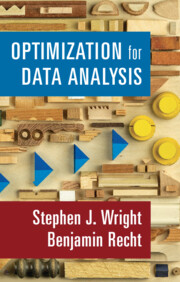Crossref Citations
This Book has been
cited by the following publications. This list is generated based on data provided by Crossref.
Sushchenko, Olha
Bezkorovainyi, Yurii
Ostroumov, Ivan
Zaliskyi, Maksym
Averyanova, Yuliya
and
Larin, Vitalii
2023.
Identification of Disturbed Stabilization Systems based on Experimental Data.
p.
1.
Sushchenko, Olha
Bezkorovainyi, Yurii
Ostroumov, Ivan
Zaliskyi, Maksym
Averyanova, Yuliya
and
Larin, Vitalii
2023.
Application of Structural Identification for Synthesis of Motion Control System.
p.
1.
Wang, Xiaoyu
and
Benning, Martin
2023.
A lifted Bregman formulation for the inversion of deep neural networks.
Frontiers in Applied Mathematics and Statistics,
Vol. 9,
Issue. ,
Grippo, Luigi
and
Sciandrone, Marco
2023.
Introduction to Methods for Nonlinear Optimization.
Vol. 152,
Issue. ,
p.
229.
De Marchi, Alberto
Jia, Xiaoxi
Kanzow, Christian
and
Mehlitz, Patrick
2023.
Constrained composite optimization and augmented Lagrangian methods.
Mathematical Programming,
Vol. 201,
Issue. 1-2,
p.
863.
Borkar, Vivek S.
and
Rao, K. S. Mallikarjuna
2023.
Elementary Convexity with Optimization.
Vol. 83,
Issue. ,
p.
131.
Sushchenko, Olha
and
Salyuk, Oleksandr
2023.
Proceedings of the International Workshop on Advances in Civil Aviation Systems Development.
Vol. 736,
Issue. ,
p.
73.
Semenov, Volodymyr
Stetsyuk, Petro
Stovba, Viktor
and
Velarde Cantú, José Manuel
2024.
One-Rank Linear Transformations and Fejer-Type Methods: An Overview.
Mathematics,
Vol. 12,
Issue. 10,
p.
1527.
Sushchenko, Olha
Bezkorovainyi, Yurii
Salyuk, Olexandr
and
Yehorov, Serhii
2024.
Proceedings of the 2nd International Workshop on Advances in Civil Aviation Systems Development.
Vol. 992,
Issue. ,
p.
73.
Bethke, Franz
Griewank, Andreas
and
Walther, Andrea
2024.
A semismooth conjugate gradients method – theoretical analysis.
Optimization Methods and Software,
Vol. 39,
Issue. 4,
p.
911.
Keith, Brendan
and
Surowiec, Thomas M.
2024.
Proximal Galerkin: A Structure-Preserving Finite Element Method for Pointwise Bound Constraints.
Foundations of Computational Mathematics,
Maheshwari, Chinmay
Cheng, James
Sastry, Shankar
Ratliff, Lillian
and
Mazumdar, Eric
2024.
Follower Agnostic Learning in Stackelberg Games.
p.
222.
Goyens, Florentin
Eftekhari, Armin
and
Boumal, Nicolas
2024.
Computing Second-Order Points Under Equality Constraints: Revisiting Fletcher’s Augmented Lagrangian.
Journal of Optimization Theory and Applications,
Vol. 201,
Issue. 3,
p.
1198.
Sushchenko, Olha
and
Bezkorovainyi, Yurii
2024.
Integrated Computer Technologies in Mechanical Engineering - 2023.
Vol. 1008,
Issue. ,
p.
112.
Wang, Shulei
2025.
Augmentation invariant manifold learning.
Journal of the Royal Statistical Society Series B: Statistical Methodology,
Hellmuth, Kathrin
Klingenberg, Christian
Li, Qin
and
Tang, Min
2025.
Reconstructing the Kinetic Chemotaxis Kernel Using Macroscopic Data: Well-Posedness and Ill-Posedness.
SIAM Journal on Applied Mathematics,
Vol. 85,
Issue. 2,
p.
613.



